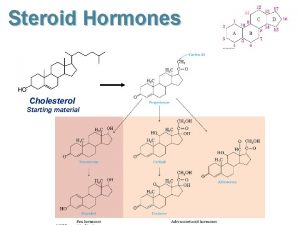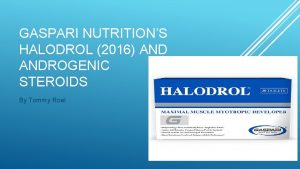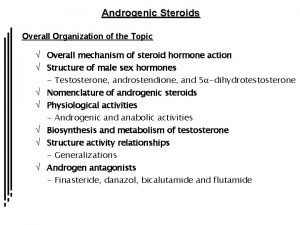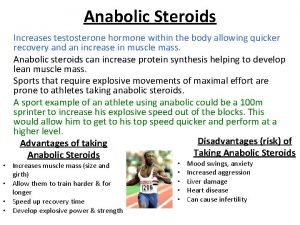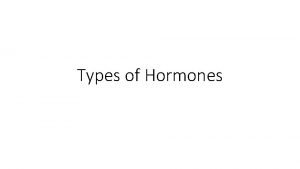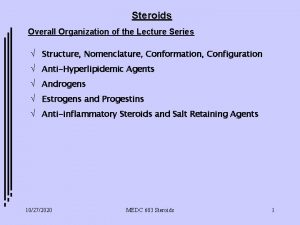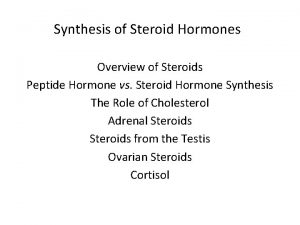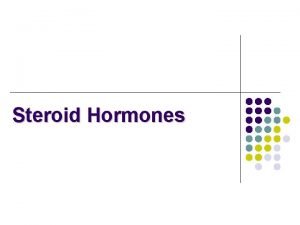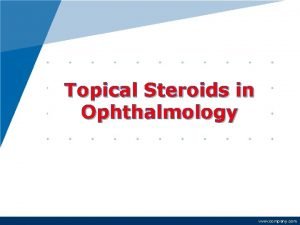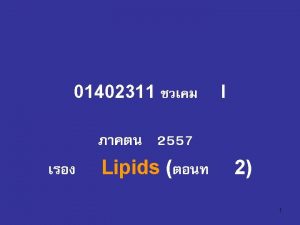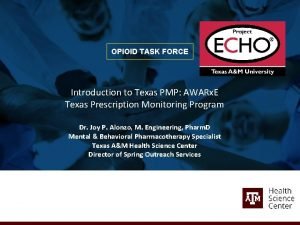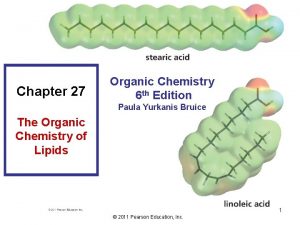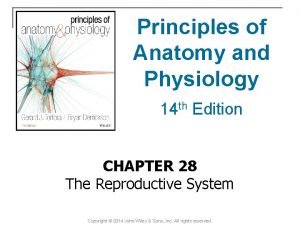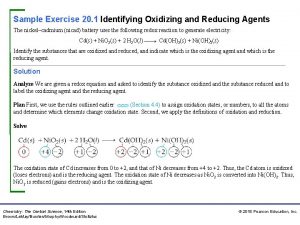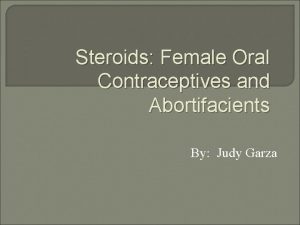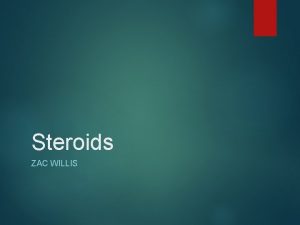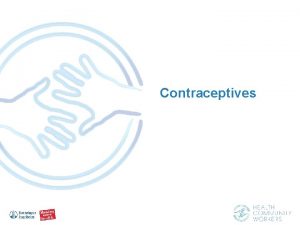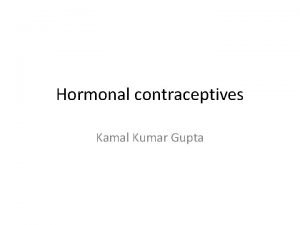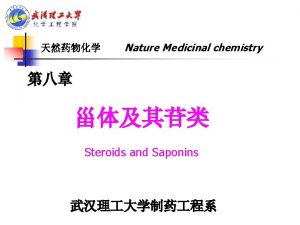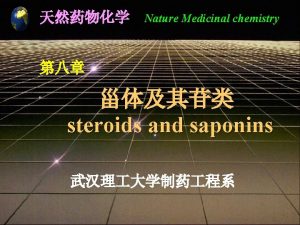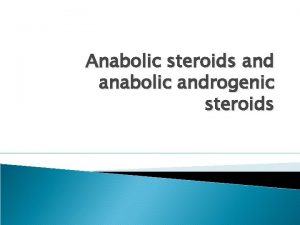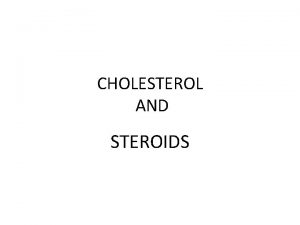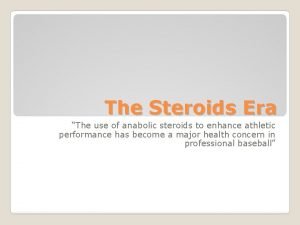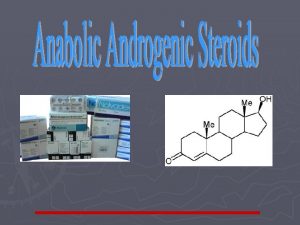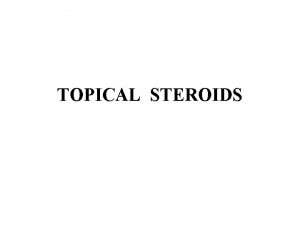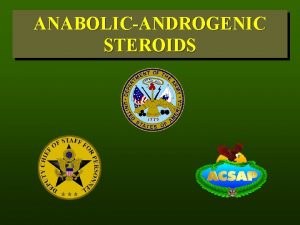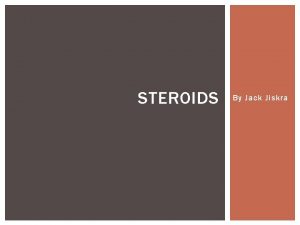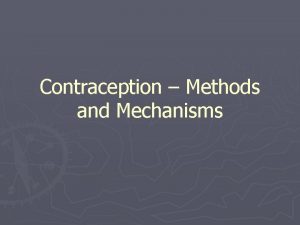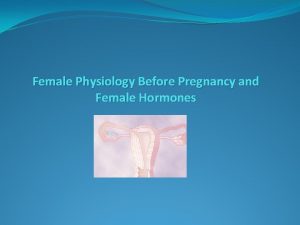Female sex steroids and contraceptives agents Female Sex



![ESTROGENS q. Estradiol [ess-tra-DYE-ole]: • also known as 17β-estradiol, is the most potent estrogen ESTROGENS q. Estradiol [ess-tra-DYE-ole]: • also known as 17β-estradiol, is the most potent estrogen](https://slidetodoc.com/presentation_image_h2/aeb3fa7e884d9d8bbf32e940ceb92b56/image-4.jpg)






















![q. Antiprogestin • Mifepristone [mih-feh-PRIH-stone] (also designated as RU-486) is a progesterone antagonist with q. Antiprogestin • Mifepristone [mih-feh-PRIH-stone] (also designated as RU-486) is a progesterone antagonist with](https://slidetodoc.com/presentation_image_h2/aeb3fa7e884d9d8bbf32e940ceb92b56/image-27.jpg)







- Slides: 34

Female sex steroids and contraceptives agents

Female Sex Hormones

• Sex hormones produced by the gonads are necessary for conception, embryonic maturation, and development of primary and secondary sexual characteristics at puberty. • The gonadal hormones are used therapeutically in replacement therapy, for ü contraception, and ü in management of menopausal symptoms. ü Several antagonists are effective in cancer chemotherapy. Ø All gonadal hormones are synthesized from the precursor, cholesterol, in a series of steps that includes shortening of the hydrocarbon side chain and hydroxylation of the steroid nucleus. Ø Aromatization is the last step in estrogen synthesis
![ESTROGENS q Estradiol esstraDYEole also known as 17βestradiol is the most potent estrogen ESTROGENS q. Estradiol [ess-tra-DYE-ole]: • also known as 17β-estradiol, is the most potent estrogen](https://slidetodoc.com/presentation_image_h2/aeb3fa7e884d9d8bbf32e940ceb92b56/image-4.jpg)
ESTROGENS q. Estradiol [ess-tra-DYE-ole]: • also known as 17β-estradiol, is the most potent estrogen produced and secreted by the ovary. • It is the principal estrogen in premenopausal women. q. Estrone [ESS-trone] is a metabolite of estradiol that has approximately one-third the estrogenic potency of estradiol. § Estrone is the primary circulating estrogen after menopause, and it is generated mainly from conversion of androstenedione in peripheral tissues. q Estriol [ess-TRI-ole], another metabolite of estradiol, is significantly less potent than is estradiol. § It is present in significant amounts during pregnancy, because it is the principal estrogen produced by the placenta. Ø A preparation of conjugated estrogens containing sulfate esters of estrone and equilin (obtained from urine of pregnant mares) is an oral preparation used for hormone replacement therapy.

Ø Plant-derived conjugated estrogen products are also available. Ø Synthetic estrogens, such as ethinyl estradiol [ETH-ih-nil ess-tra-DYE-ole], undergo less firstpass metabolism than do naturally occurring steroids and, thus, are effective when administered orally at lower doses. Ø Nonsteroidal compounds that bind to estrogen receptors and exert either estrogenic or antiestrogenic effects on target tissues are called selective estrogen receptor modulators (SERMs). Ø These include tamoxifen and raloxifene, among others.

Mechanism of action o After dissociation from their binding sites on sex hormone–binding globulin or albumin in the plasma, steroid hormones diffuse across the cell membrane and bind with high affinity to specific nuclear receptor proteins § The activated steroid–receptor complex interacts with nuclear chromatin to initiate hormone-specific RNA synthesis. ü This results in the synthesis of specific proteins that mediate a number of physiologic functions. v The steroid hormones may elicit the synthesis of different RNA species in diverse target tissues and, therefore, are both receptor and tissue specific. § Other pathways that require these hormones have been identified that lead to more rapid actions. o For example, activation of an estrogen receptor in the membranes of hypothalamic cells has been shown to couple to a G protein, thereby initiating a second-messenger cascade. o In addition, estrogen-mediated dilation of coronary arteries occurs by the increased formation and release of nitric oxide and prostacyclin in endothelial cells.


q. Therapeutic uses Ø Estrogens are most frequently used for: ü Contraception. ü Postmenopausal hormone therapy (HT). ü Estrogens were previously widely used for prevention of osteoporosis, but current guidelines recommend use of otherapies such as alendronate over estrogen. ü Estrogens are also used for replacement therapy in premenopausal patients who are deficient in this hormone. v. Estrogen deficiency can be due to inadequate functioning of the ovaries (hypogonadism), premature menopause, or surgical menopause.

q. Postmenopausal HT: Ø The primary indication for estrogen therapy in postmenopausal women is menopausal symptoms, such as vasomotor instability (for example, “hot flashes” or “hot flushes”) and vaginal atrophy For women who have an intact uterus Ø progestogen is always included with the estrogen therapy, because the combination reduces the risk of endometrial carcinoma associated with unopposed estrogen. • For women who have undergone a hysterectomy, unopposed estrogen therapy is recommended because progestins may unfavorably alter the beneficial effects of estrogen on lipid parameters.

• The amount of estrogen used in replacement therapy is substantially less than the doses used in oral contraception. Ø Thus, the adverse effects of estrogen replacement therapy are usually less pronounced than those seen in women taking estrogen for contraceptive purposes. • Delivery of estradiol by transdermal patch or gel is also effective in treating postmenopausal symptoms. • Due to concerns over the risks of HT (increased risk of cardiovascular events and breast cancer), HT should be prescribed at the lowest effective dose for the shortest possible time to relieve menopausal symptoms. ü Women who only have urogenital symptoms, such as vaginal atrophy, should be treated with vaginal rather than systemic estrogen.

Ø Contraception: • The combination of an estrogen and progestogen provides effective contraception via the oral, transdermal, or vaginal route. Ø Other uses: § Estrogen therapy mimicking the natural cyclic pattern, and usually in combination with a progestogen, is instituted to stimulate development of secondary sex characteristics in young women with primary hypogonadism. ü Continued treatment is required after growth is completed. § Similarly, estrogen and progestogen replacement therapy is used for women who have premature menopause or premature ovarian failure.


q Pharmacokinetics: Ø Naturally occurring estrogens: o These agents and their esterified or conjugated derivatives are readily absorbed through the gastrointestinal tract, skin, and mucous membranes. o Taken orally, estradiol is rapidly metabolized (and partially inactivated) by the microsomal enzymes of the liver. o Micronized estradiol is available and has better bioavailability. o Although there is some first-pass metabolism, it is not sufficient to lessen the effectiveness when taken orally. Ø Synthetic estrogen analogs: Ø These compounds, such as ethinyl estradiol, mestranol [MES-trah-nole], and estradiol valerate, are well absorbed after oral administration. o Mestranol is quickly demethylated to ethinyl estradiol, which is metabolized more slowly than the naturally occurring estrogens by the liver and peripheral tissues. o Estradiol valerate is rapidly cleaved to estradiol and valeric acid. o Being fat soluble, they are stored in adipose tissue, from which they are slowly released. v Therefore, the synthetic estrogen analogs have a prolonged action and a higher potency compared to those of natural estrogens.

Metabolism: • Estrogens are transported in the blood bound to serum albumin or sex hormone–binding globulin. • As mentioned above, bioavailability of estrogen taken orally is low due to first pass metabolism. • To reduce first-pass metabolism, the drugs may be administered via the transdermal route (patch, topical gel, topical emulsion, or spray), intravaginally (tablet, cream, or ring), or by injection.

Adverse effects • Nausea and breast tenderness are among the most common adverse effects of estrogen therapy. • In addition, the risk of thromboembolic events, myocardial infarction, and breast and endometrial cancer is increased with use of estrogen therapy. üThe increased risk of endometrial cancer can be offset by including a progestogen along with the estrogen therapy.

SELECTIVE ESTROGEN RECEPTOR MODULATORS (SERMs) ü SERMs are a class of estrogen-related compounds that display selective agonism or antagonism for estrogen receptors depending on the tissue type. • This category includes tamoxifen, toremifene, raloxifene, clomiphene, and ospemifene. Ø A. Mechanism of action • Tamoxifen [tah-MOKS-ih-fen], toremifene [tore-EM-ifeen], and raloxifene [rah-LOX-ih-feen] compete with estrogen for binding to the estrogen receptor in breast tissue. • Normal breast growth is stimulated by estrogens. • Therefore, some breast tumors regress following treatment with these agents.

• Raloxifene acts as an estrogen agonist in bone, leading to decreased bone resorption, increased bone density, and decreased vertebral fractures • Unlike estrogen and tamoxifen, raloxifene does not have appreciable estrogen receptor agonist activity in the endometrium and, therefore, does not predispose to endometrial cancer. • Raloxifene also lowers serum total cholesterol and lowdensity lipoprotein (LDL). • Clomiphene [KLOE-mifeen] acts as a partial estrogen agonist and interferes with the negative feedback of estrogens on the hypothalamus. This effect increases the secretion of gonadotropin-releasing hormone and gonadotropins, thereby leading to stimulation of ovulation.


q. Therapeutic uses: • Tamoxifen is currently used in the treatment of metastatic breast cancer • or as adjuvant therapy following mastectomy or radiation for breast cancer. • Both tamoxifen and raloxifene can be used as prophylactic therapy to reduce the risk of breast cancer in high-risk patients. • Raloxifene is also approved for the prevention and treatment of osteoporosis in postmenopausal women. • Clomiphene is useful for the treatment of infertility associated with anovulatory cycles. • Ospemifene is indicated for the treatment of dyspareunia (painful sexual intercourse) related to menopause. v The SERMs are rapidly absorbed after oral administration.

Adverse effects • Adverse effects of clomiphene are dose related and include headache, nausea, vasomotor flushes, visual disturbances, and ovarian enlargement. • Use of clomiphene increases the risk of multiple births (twins or triplets). • The most frequent adverse effects of tamoxifen and toremifene are hot flashes and nausea. • Due to its estrogenic activity in the endometrium, endometrial hyperplasia and malignancies have been reported with tamoxifen therapy. ü This has led to recommendations for limiting the length of time on the drug for some indications. • Hot flashes and leg cramps are common adverse effects with raloxifene. ü In addition, there is an increased risk of deep vein thrombosis, pulmonary embolism, and retinal vein thrombosis. • Women who have a past or active history of venous thromboembolic events should not take the drug.

PROGESTOGENS • Progesterone, the natural progestogen, is produced in response to luteinizing hormone (LH) by both females (secreted by the corpus luteum, primarily during the second half of the menstrual cycle, and by the placenta) and by males (secreted by the testes). • It is also synthesized by the adrenal cortex in both sexes.

Mechanism of action q Progestogens exert their mechanism of action in a manner analogous to that of the other steroid hormones. • In females, progesterone promotes the development of a secretory endometrium that can accommodate implantation of a newly forming embryo. • The high levels of progesterone that are released during the second half of the menstrual cycle (the luteal phase) inhibit the production of gonadotropin and, therefore, prevent further ovulation. • If conception takes place, progesterone continues to be secreted, maintaining the endometrium in a favorable state for the continuation of the pregnancy and reducing uterine contractions. • If conception does not take place, the release of progesterone from the corpus luteum ceases abruptly. • This decline stimulates the onset of menstruation.


q Therapeutic uses of progestogens • The major clinical uses of progestogens are for contraception or the treatment of hormone deficiency. • For contraception, they are often used in combination with estrogens. • Progesterone by itself is not used widely as a contraceptive therapy because of its rapid metabolism, resulting in low bioavailability. • Synthetic progestogens (that is, progestins) used in contraception are more stable to firstpass metabolism, allowing lower doses when administered orally. • These agents include desogestrel [des-oh-JES-trel], dienogest [dye- ENoh-jest], drospirenone [droe-SPY-re-none], levonorgestrel [leevoe-nor. JES-trel], norethindrone [nor-ETH-in-drone], norethindrone acetate, norgestimate [nor-JES-tih-mate], and norgestrel [nor-JEStrel]. • Medroxyprogesterone [me-DROK-see-proe-JES-ter-one] acetate is an injectable contraceptive, • the oral form is a common progestin component of postmenopausal HT. • Progestins are also used for the control of dysfunctional uterine bleeding, treatment of dysmenorrhea, and management of endometriosis and infertility.

q. Pharmacokinetics • A micronized preparation of progesterone is rapidly absorbed after oral administration. • It has a short half-life in the plasma and • almost completely metabolized by the liver. • Synthetic progestins are less rapidly metabolized. o Oral medroxyprogesterone acetate has a half-life of 30 days. o When injected intramuscularly or subcutaneously, it has a half-life of about 40 to 50 days and provides contraceptive activity for approximately 3 months. o The other progestins have half-lives of 1 to 3 days, allowing for once-daily dosing.

q. Adverse effects • The major adverse effects associated with the use of progestins are headache, depression, weight gain, and changes in libido. • Progestins that are derived from 19 -nortestosterone (for example, norethindrone acetate, norgestrel, levonorgestrel) possess some androgenic activity because of their structural similarity to testosterone and can cause acne and hirsutism. • Less androgenic progestins, such as norgestimate and drospirenone, may be preferred in women with acne. • Drospirenone may raise serum potassium due to antimineralocorticoid effects.
![q Antiprogestin Mifepristone mihfehPRIHstone also designated as RU486 is a progesterone antagonist with q. Antiprogestin • Mifepristone [mih-feh-PRIH-stone] (also designated as RU-486) is a progesterone antagonist with](https://slidetodoc.com/presentation_image_h2/aeb3fa7e884d9d8bbf32e940ceb92b56/image-27.jpg)
q. Antiprogestin • Mifepristone [mih-feh-PRIH-stone] (also designated as RU-486) is a progesterone antagonist with partial agonist activity. • Administration of this drug to females early in pregnancy usually results in abortion of the fetus due to interference with the progesterone needed to maintain pregnancy. • Mifepristone is often combined with the prostaglandin analog misoprostol (administered orally or intravaginally) to induce uterine contractions. • The major adverse effects are significant uterine bleeding and the possibility of an incomplete abortion

Contraceptives

ü Currently, interference with ovulation is the most common pharmacologic intervention for prevention of pregnancy. q. Major classes of contraceptives 1. Combination oral contraceptives: § Products containing a combination of an estrogen and a progestin are the most common type of oral contraceptives. § Monophasic combination pills contain a constant dose of estrogen and progestin given over 21 to 24 days.

• Triphasic oral contraceptive products attempt to mimic the natural female cycle and most contain a constant dose of estrogen with increasing doses of progestin given over three successive 7 -day periods. ü The combination of estradiol valerate and dienogest is available as a four -phasic oral contraceptive. v With most oral contraceptives, active pills are taken for 21 to 24 days, followed by 4 to 7 days of placebo, for a total regimen of 28 days. • Withdrawal bleeding occurs during the hormone-free (placebo) interval. ü The most common estrogen in the combination pills is ethinyl estradiol. ü The most common progestins are norethindrone, norethindrone acetate, levonorgestrel, desogestrel, norgestimate, and drospirenone. • These preparations are highly effective in achieving contraception. • Use of extended-cycle contraception (84 active pills followed by 7 days of placebo) results in less frequent withdrawal bleeding. • A continuous oral contraceptive product (active pills taken every day) is also available.

2. Transdermal patch: • An alternative to combination oral contraceptives is a transdermal patch containing ethinyl estradiol and the progestin norelgestromin. • One contraceptive patch is applied each week for 3 weeks to the abdomen, upper torso, or buttock. • No patch is worn during the 4 th week, and withdrawal bleeding occurs. • The transdermal patch has efficacy comparable to that of the oral contraceptives, but it is less effective in women weighing greater than 90 kg. • Contraindications and adverse effects for the patch are similar to those of oral contraceptives. • Total estrogen exposure with the transdermal patch may be significantly greater than that seen with oral contraceptives. • Increased exposure to estrogen may increase the risk of adverse events such as thromboembolism.

3. Vaginal ring: • An additional contraceptive option is a vaginal ring containing ethinyl estradiol and etonogestrel. • The ring is inserted into the vagina and is left in place for 3 weeks and then removed. • No ring is used during the fourth week, and withdrawal bleeding occurs. • The contraceptive vaginal ring has efficacy, contraindications, and adverse effects similar to those of oral contraceptives.

4. Progestin-only pills: • Products containing a progestin only, usually norethindrone (called a “mini-pill”), are taken daily on a continuous schedule. • Progestin-only pills deliver a low, continuous dosage of drug. These preparations are less effective than combination products and they may produce irregular menstrual cycles more frequently. • The progestin-only pill may be used for patients who are breast-feeding (unlike estrogen, progestins do not have an effect on milk production), are intolerant to estrogen, are smokers, or have other contraindications to estrogen- containing products.

5. Injectable progestin: • Medroxyprogesterone acetate is a contraceptive that is administered via intramuscular or subcutaneous injection every 3 months. • Weight gain is a common adverse effect. • Because this product provides high sustained levels of progestin, many women experience amenorrhea with medroxyprogesterone acetate. • In addition, return to fertility may be delayed for several months after discontinuation. • Medroxyprogesterone acetate maycontribute to bone loss and predispose patients to osteoporosis and/or fractures. ü Therefore, the drug should not be continued for more than 2 years unless the patient is unable to tolerate other contraceptive options.
 Aminopeptin
Aminopeptin Kurt bumby
Kurt bumby Sex sex sex
Sex sex sex Xxtesticles
Xxtesticles Sex sex sex
Sex sex sex Sex sex sex
Sex sex sex Steroids and cholesterol
Steroids and cholesterol X linked punnett square
X linked punnett square Advanced higher biology unit 2
Advanced higher biology unit 2 Sex determination and sex linkage
Sex determination and sex linkage Sex male and female
Sex male and female Halodrol gaspari
Halodrol gaspari Endocrine molecules
Endocrine molecules Steroids structure
Steroids structure Anabolic steroids
Anabolic steroids Steroid hormones lipids
Steroid hormones lipids Picture of steroids
Picture of steroids Steroid medicine list
Steroid medicine list Role of steroid hormones
Role of steroid hormones Adelphi research steroids
Adelphi research steroids Steroids meaning
Steroids meaning Active form of vitamin d
Active form of vitamin d Hormone8
Hormone8 Pmp steroids
Pmp steroids Restasis cost
Restasis cost Terpenes steroids prostaglandins
Terpenes steroids prostaglandins Once a sex offender always a sex offender
Once a sex offender always a sex offender What is gonads
What is gonads System reproductive female
System reproductive female Female sex organ
Female sex organ Function of uterus ppt
Function of uterus ppt Secondary agents of socialization
Secondary agents of socialization Identify oxidizing and reducing agents practice
Identify oxidizing and reducing agents practice Oxidizing vs reducing agent
Oxidizing vs reducing agent Get5gets.com
Get5gets.com






